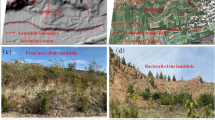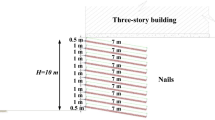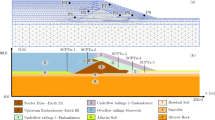Abstract
When water permeates the loess, the strength of the loess will be greatly reduced; thus, it is necessary to study the effect of seepage on the seismic response of a loess tunnel. Fields of structure and fluid are simulated using ADINA, and the calculation model of a curved wall loess tunnel with a super-large section (LTSLS) is established. Rainwater is simulated using an incompressible constant parameter model. Considering the action of near- and far-field earthquake and pulse effects, the Galerkin method is used to solve the interaction of stress and seepage fields. By contrasting and analyzing the maximum principal stress, the minimum principal stress, the maximum displacement of lining and the internal force of the tunnel structure, the influence of rainwater seepage on the mechanical properties of LTSLS is studied, and meanwhile, dynamic responses of LTSLS under the interaction of rainwater seepage and earthquakes are studied. The results show that if rainwater seepage is only considered for shallow buried LTSLS, the pore water pressure of a tunnel is so small that it may be neglected. The damage degree of LTSLS under the interaction of rainwater seepage and earthquakes is more than that under a single field. When considering the interaction effect of rainwater and earthquakes, the pore water pressure, principal stress and displacement under a near-field earthquake with pulse effect are greater than those under a near-field earthquake without pulse effect and a far-field earthquake under the same condition.










Similar content being viewed by others
Abbreviations
- K :
-
Stiffness matrix
- ΔS :
-
Displacement increment
- L :
-
Nodal forces corresponding to the pore water pressure among nodes
- ΔP :
-
Increment of pore water pressure
- F :
-
External node load
- I :
-
Unbalanced force of the previous incremental step in the iterative process
- \({\hat{\varvec{B}}}\) :
-
Volume change rate corresponding to the node deformation rate
- \(\varvec{\nu}\) :
-
Derivative of S with respect to time
- \({\hat{\varvec{H}}}\) :
-
Volume change rate corresponding to pore pressure change
- P :
-
Pore water pressure
- Q :
-
Flow quantity by node
- B :
-
Volume change corresponding to node deformation
- t :
-
Time
- H :
-
Fluid volume change corresponding to pore water pressure change
- R :
-
Correction of fluid volume change
- M :
-
Mass matrix
- C :
-
Damping matrix
- \({\ddot{\varvec{u}}}\left( {\varvec{t}} \right)\) :
-
Acceleration vector of a node
- \({\dot{\varvec{u}}}\left( {\varvec{t}} \right)\) :
-
Velocity vector of a node
- \({\varvec{u}}\left( {\varvec{t}} \right)\) :
-
Displacement vector of a node
- \({\ddot{\varvec{u}}}_{{\varvec{g}}}\) :
-
Earthquake acceleration
- \({\varvec{P}}_{{\varvec{f}}}\) :
-
Surface load vector
- \(\gamma\) :
-
One of the basic constant parameters of Newmark-β
- δ :
-
The other of the basic constant parameters of Newmark-β
- T max :
-
Biggest vibration period of an isolated body
- \(\alpha_{T}\) :
-
Tangential correction coefficient
- \(\alpha_{N}\) :
-
Normal correction coefficient
- K BN :
-
Normal spring stiffness
- K BT :
-
Tangential spring stiffness
- C BN :
-
Damping of the normal damper
- C BT :
-
Damping of the tangential damper
References
Anastasopoulos I, Gerolymos N, Drosos V et al (2007) Nonlinear response of deep immersed tunnel to strong seismic shaking. J Geotech Geoenviron Eng 133(9):1067–1090
Chen L (2010) Experimental study on maximum dynamic elastic modulus of unsaturated loess. J Anhui Agric Sci 38(11):6036–6037
Chen LW, Peng JB, Fan W (2007) Stability of loess-hidden hole under earthquake. J Chang’an Univ 27(6):34–38
Cheng XS, Zheng YR (2011) Calculation discussion about safety factor of unlined loess tunnel wall rock structure under earthquake. Rock Soil Mech 32(3):761–766
Cheng XS, Tian RR, Wang JL et al (2010) Static and seismic stability analysis of soil surrounding tunnel about large-span unlined egg-shaped loess tunnel. China Civil Eng J 43(S):582–587
Cheng XS, Tian RR, Zheng YR (2011a) Earthquake stability analysis of wall rock of vertical ridge loess tunnel: the impact of stress concentration at tunnel feet on safety factor. J Vib Shock 30(11):214–218
Cheng XS, Zheng YR, Tian RR (2011b) Dynamic finite element strength reduction method of earthquake stability analysis of surrounding rock of tunnel. Rock Soil Mech 32(4):1241–1248
Cheng XS, Wang JH, Du XL (2013) Fluid-solid coupling based seismic response analysis of subsea tunnels during seepage. Mod Tunn Technol 50(6):44–51
Cheng XS, Dowding CH, Tian RR (2014) New methods of safety evaluation for rock/soil mass surrounding tunnel under earthquake. J Cent South Univ 21(7):2935–2943
Cui WJ (1991) An experimental research on the dynamic properties of intact loess. J China Railw Soc 4:71–77
Gu ZQ, Peng SZ, Li ZK (1994) Underground excavation engineering. Tsinghua University Press, Beijing
Guo KX (2015) Study on dynamic triaxial test of unsaturated loess. Chang’an University, Xi’an
Li XA, Peng JB, Fan W et al (2005) Influencing factors and regularity of dynamic parameters of highway loess subgrade. J Highw Transp Res Dev 22(6):87–91
Li RD, Zhang HR, Bai XH et al (2007) Dynamic shear strength and seismic subsidence of intact loess with different water contents from dynamic triaxial testing. J Eng Geol 15(5):694–699
Li S, Liu SL, Yao ML et al (2008) Influence of seepage on stability of earth-rock dam in plain area under seismic loading. Chin J Rock Mech Eng 27(4):858–864
Li L, He C, Geng P et al (2012) Analysis of seismic dynamic response of tunnel through fault zone in high earthquake intensity area. J Chongqing Univ 35(6):92–98
Liu CJ (2013) Numerical simulation analysis of earthquake stability about the Niutoushan loess railway tunnel. Chin J Undergr Sp Eng 9(3):547–551
Liu QJ, Zhao YY (2011) Dynamic stability of circular tunnel linings subjected to radial harmonic excitation. J Hunan Univ 38(9):22–26
Luo YS, Xie DY, Chen CL (2001) Test analysis of dynamic failure strength of loess under different moisture conditions. J Xi’an Univ Technol 17(4):403–407
Luo YS, Li R, Tian KL (2007) Research on method of dynamic characteristics test for unsaturated loess. Chin J Undergr Sp Eng 3(6):1041–1046
Navas Pedro (2013) Susana López-Querol. Generalized unconfined seepage flow model using displacement based formulation. Eng Geol 166:140–151
Peila DA (1994) Theoretical study of reinforcement influence on the stability of a tunnel face. Geotech Geol Eng 12(3):145–168
Pellet F, Descoeudres F, Egger P (1993) The effect of water seepage forces on the face stability of an experimental micro tunnel. Can Geotech J 30(2):363–369
Pellet F, Amini Hosseini K, Jafari MK et al (2005) Geotechnical performance of Qantas during the 2003 Bam, Iran, earthquake. Earthq Eng Res Inst 21(S1):137–164
Perazzelli P, Leone T, Anagnostou G (2014) Tunnel face stability under seepage flow conditions. Tunn Undergr Space Technol 43:459–469
Sun ZJ, Shen JM, Ma L (2013) Stability analysis of surrounding rock of loess tunnel with the consideration of seepage. In: National conference on structural engineering
Tan DY, Luo YS, Wang ZJ et al (2010) Experimental research on dynamic strength characteristics of loess under dynamic torsional shears. China Rural Water Hydropower 8:110–112
Tian KL, Zhang HL, Zhang BP et al (2007) Research on static and dynamic strength of unsaturated loess and the correlation between them. J Disaster Prev Mitig Eng 27(1):91–95
Wang J, Shi YC, Wang Q et al (2012) Study on dynamic strength properties of undisturbed loess under natural moisture content. World Earthq Eng 8(4):23–27
Wang SH, Gao B, Wang YX et al (2013a) Analysis and research of the dynamic response rule and anti-seismic measures for mountain tunnels in a high-intensity earthquake area. Mod Tunn Technol 50(5):60–67
Wang P, Wang J, Chai SF et al (2013b) A study of the dynamic strength regional characteristics of percentile(Q3) loess. Hydrogeol Eng Geol 40(5):69–73
Xiao Q, Zheng YR, Ye HL (2010) Stability analysis of static unlined loess tunnel. Chin J Undergr Sp Eng 6(6):1136–1141
Xu H, Zhu YW, Cai YQ et al (2005) Stability analysis of unsaturated soil slopes under rainfall infiltration. Rock Soil Mech 26(12):1957–1962
Yang ZH, Lan HX, Zhang YS et al (2013) Rock dynamic response of railway tunnel traversing through fault under strong earthquake. J Eng Geol 21(2):171–181
Zhang JH, Yang XL, Zhang B (2015) Upper bound quasi-static analysis of dynamic stability on shallow tunnel under earthquake action. J Cent South Univ 46(1):238–247
Zhao QP, Yu Y, Wang MN et al (2009) Study on the deformation regularity and preset deformations for large section tunnels in loess. Mod Tunn Technol 46(6):64–69
Acknowledgements
This paper is a part of the education ministry doctoral tutor foundation of China (Grant No.: 20136201110003) and a part of the national natural science foundation of China (Grant No.: 51478212).
Author information
Authors and Affiliations
Corresponding author
Ethics declarations
Conflict of interest
The authors declare that there is no conflict of interest regarding the publication of this paper.
Rights and permissions
About this article
Cite this article
Cheng, X., Feng, H., Qi, S. et al. Dynamic Response of Curved Wall LTSLS Under the Interaction of Rainwater Seepage and Earthquake. Geotech Geol Eng 35, 903–914 (2017). https://doi.org/10.1007/s10706-016-0148-x
Received:
Accepted:
Published:
Issue Date:
DOI: https://doi.org/10.1007/s10706-016-0148-x




